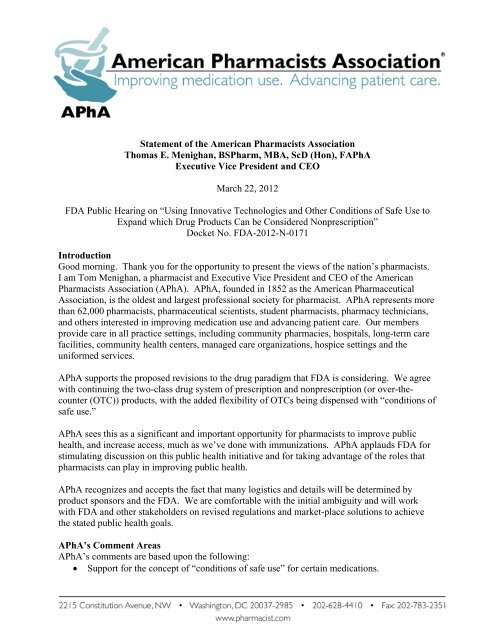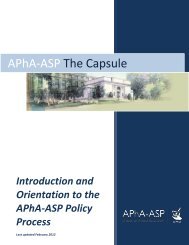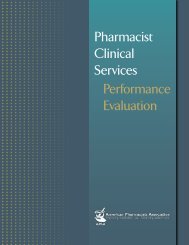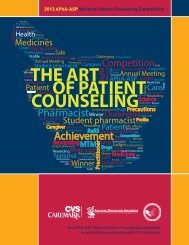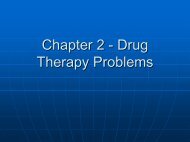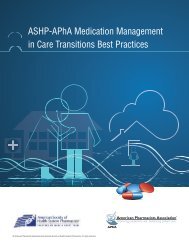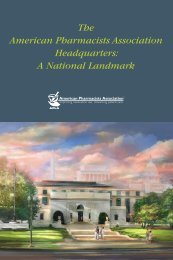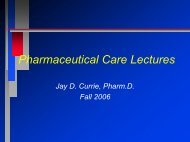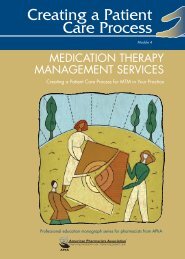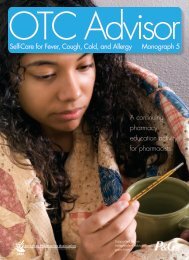complete testimony - American Pharmacists Association
complete testimony - American Pharmacists Association
complete testimony - American Pharmacists Association
You also want an ePaper? Increase the reach of your titles
YUMPU automatically turns print PDFs into web optimized ePapers that Google loves.
Statement of the <strong>American</strong> <strong>Pharmacists</strong> <strong>Association</strong>Thomas E. Menighan, BSPharm, MBA, ScD (Hon), FAPhAExecutive Vice President and CEOMarch 22, 2012FDA Public Hearing on “Using Innovative Technologies and Other Conditions of Safe Use toExpand which Drug Products Can be Considered Nonprescription”Docket No. FDA-2012-N-0171IntroductionGood morning. Thank you for the opportunity to present the views of the nation’s pharmacists.I am Tom Menighan, a pharmacist and Executive Vice President and CEO of the <strong>American</strong><strong>Pharmacists</strong> <strong>Association</strong> (APhA). APhA, founded in 1852 as the <strong>American</strong> Pharmaceutical<strong>Association</strong>, is the oldest and largest professional society for pharmacist. APhA represents morethan 62,000 pharmacists, pharmaceutical scientists, student pharmacists, pharmacy technicians,and others interested in improving medication use and advancing patient care. Our membersprovide care in all practice settings, including community pharmacies, hospitals, long-term carefacilities, community health centers, managed care organizations, hospice settings and theuniformed services.APhA supports the proposed revisions to the drug paradigm that FDA is considering. We agreewith continuing the two-class drug system of prescription and nonprescription (or over-thecounter(OTC)) products, with the added flexibility of OTCs being dispensed with “conditions ofsafe use.”APhA sees this as a significant and important opportunity for pharmacists to improve publichealth, and increase access, much as we’ve done with immunizations. APhA applauds FDA forstimulating discussion on this public health initiative and for taking advantage of the roles thatpharmacists can play in improving public health.APhA recognizes and accepts the fact that many logistics and details will be determined byproduct sponsors and the FDA. We are comfortable with the initial ambiguity and will workwith FDA and other stakeholders on revised regulations and market-place solutions to achievethe stated public health goals.APhA’s Comment AreasAPhA’s comments are based upon the following:• Support for the concept of “conditions of safe use” for certain medications.
APhA Statement at FDA Public Hearing on Potential New Drug Paradigm and Conditions of Safe UseMarch 22, 2012• The opportunity to expand patient access, improve public health, and provide anotheravenue to bring people who may have poorly treated chronic conditions back into thehealth care system.• The opportunity to further communicate and collaborate with physicians and otherproviders.• The success of pharmacist-administered immunizations and other patient care programson improving public health. And,• A recognition that there are several key focus areas to consider as the new paradigmconcept evolves.APhA’s General Support of Dispensing Medications with “Conditions of Safe Use”<strong>Pharmacists</strong> are the most accessible health care provider to many patients. This is not acompetitive statement, but rather an acknowledgement of the fact that there are more than 60,000pharmacies in the U.S. where consumers can walk in during often extended hours and haveaccess to a pharmacist. We view the new drug paradigm concept being considered by FDA as anexciting opportunity to utilize this open access to pharmacists to safely increase the availabilityof certain medications and to optimize the important role pharmacists can play in improvingpublic health.APhA greatly appreciates FDA referencing the use of a pharmacist intervention as a possible“condition of safe use,” in addition to the use of innovative technologies. We believe that moreopportunities for pharmacist-patient interventions and communication will lead to improvedmedication use and improved health outcomes.Importantly, we also see this as a great opportunity to reconnect and link patients back into thehealth care system. We see millions of patients who may have dropped out of therapy, may benon-compliant with therapy, or may be the "walking well" but may have an undertreated chroniccondition. It is widely known in pharmacy, but often not well documented, that pharmacistsroutinely refer patients to an appropriate provider, and improve care coordination, everyday.We also see this proposed new paradigm as a way to ensure that patients have another avenue toaccess life-saving, emergency drugs such as antidotes and rescue medications through approvedalgorithms, documentation, standards of care, and other appropriate requirements for “conditionsof safe use” for a specific product as pursued by the product sponsor.<strong>Pharmacists</strong> are committed to a team-based approach to patient care. The new paradigm beingconsidered should not segment or silo patient care activity in the pharmacy but rather provide forredirecting undertreated patients back into care to reduce morbidity and decrease costs.While we do not know what the future holds in health care, innovations and technology willcontinue to challenge current delivery structures and processes. FDA needs the tools andflexibility to utilize and respond to innovative technologies, patient care strategies and needs,challenges, and other developments as they evolve.When this meeting announcement was published we stimulated discussion in the pharmacycommunity with a blog and other social media. <strong>Pharmacists</strong> responded quite positively, and inessence said public health could improve with greater involvement of pharmacists.2
APhA Statement at FDA Public Hearing on Potential New Drug Paradigm and Conditions of Safe UseMarch 22, 2012APhA’s View of the New Drug Continuum Being Considered by FDAAPhA sees the new paradigm concept fitting into the overall drug safety continuum much likerisk evaluation and mitigation strategies, or REMS, do by allowing access to certain prescriptiondrugs. Focusing on less risk and the OTC side of the drug continuum (the gray column in Figure1) we can visualize how the new drug paradigm would allow more flexible access to drugs thatwould remain prescription-only absent the “conditions of safe use” being considered by FDA.Draft New Drug Paradigm Being Considered by FDA:Creating more flexibility on the drug safety continuum tobenefit patients and public healthOTCsDraftNewFDAIdeaPrescriptiondrugsREMSDrugs that would notreceive FDAapproval or beallowed to remainon the marketbecause therisk outweighs thebenefitAverage Risk of DrugSource: <strong>American</strong> <strong>Pharmacists</strong><strong>Association</strong>Figure 1.Drugs that wouldremain prescriptionabsent “conditions ofsafe use” beingconsidered by FDAPrescription drugs thatwould not be FDAapprovedor remain on the marketwithout a REMSBuilding on Pharmacy’s Successful Immunization ModelOver the last decade or so, all states enacted laws and regulations to empower pharmacists toimmunize. As experience increased and opportunities to improve public health presentedthemselves, pharmacists sought out the training and the rest is history – today, more than175,000 pharmacists <strong>complete</strong>d certificate training programs. And, in the 2010-11 influenzaseason, it is estimated that pharmacists administered approximately 20 million influenzavaccinations, thus meeting a major public health need for improved immunization rates andaccess.APhA believes that the new paradigm being considered can build on the successfulimmunization public health model. We would hope to implement new training processes, scaleupacross pharmacy practice settings, and collaborate with the medical community to help fill theneeds of our patients and improve public health.3
APhA Statement at FDA Public Hearing on Potential New Drug Paradigm and Conditions of Safe UseMarch 22, 2012APhA’s Key Focus Areas as “Conditions of Safe Use” are ConsideredAs FDA considers this new paradigm, we suggest the following 8 key focus areas:1. Evidence and Clinical Experience: As currently described, we appreciate and understandthat approval of any product in the new paradigm would need to be based on science,clinical evidence of efficacy and patient safety in actual use.2. Public Input: There must be an opportunity for public input on any sponsor’s proposalfor a product moving through an application process with “conditions of safe use.”3. Consistent Definitions and Processes: The process for drug availability through“conditions of safe use” must be defined in a uniform and standardized process.o Any new paradigm must ensure that the patient care and drug dispensingprocesses are not disjointed, variable or confusing across different practicesettings.4. Communication Technology: Pharmacist-patient care activities could be communicatedthrough phone calls and faxes but more efficiently and efficiently through the expandinguse of health information technology (HIT) infrastructure and electronic health records(EHRs).o Pharmacy organizations, through the Pharmacy e-HIT Collaborative, are workingtogether on HIT and privacy issues to promote the delivery, communication anddocumentation of and billing for pharmacist-provided services.5. Use of Practice Algorithms: A pharmacist-patient intervention as part of a “conditions ofsafe use” to determine appropriate dispensing should be built upon consensus-based,best-practice algorithms for pharmacists to implement and communicate with otherproviders.o Such interventions could include screening, assessment and consultation, orreferral of the individual to the physician or other appropriate health careprovider. Further, these processes might rightly be developed in collaborationamong professions involved.6. Ability to Bill for Services: <strong>Pharmacists</strong> must be able to bill, via a standardizedmechanism, and be compensated for the clinical services required to dispense productswith “conditions for safe use”.o APhA appreciates that in the meeting notice FDA recognizes the paymentchallenges for any new drug paradigm. We understand that such paymentsolutions for “conditions of safe use” activities may be market-driven and notunder the purview of FDA.o However, without a viable business model these services will not be sustained andthe benefits would not be realized.o FDA’s initiatives should not preclude payment for pharmacists’ services by thepatient, third-party payers, state programs, Medicare, the sponsor, or others.o In addition, consideration should be given to legislatively provide CMS with theoption of creating a regulatory system where pharmacists could be compensated4
APhA Statement at FDA Public Hearing on Potential New Drug Paradigm and Conditions of Safe UseMarch 22, 2012for providing these services to Medicare patients so that a viable self-sustainingbusiness model can be created if CMS or other payers see value in such an option.o We recognize that payers will need to determine payment policies for nonprescriptionmedications that may require “conditions of safe use”.7. Provider Education: Education about a new paradigm must focus on the availability of aproduct, the targeted patient population, processes and logistical requirements of theprogram, clinical nuances, and resource materials for the pharmacist.o <strong>Pharmacists</strong> are the medication experts and are well qualified to provide clinicalinterventions on the safe use of a product, just as we already do with prescriptionand OTC products.o <strong>Pharmacists</strong> train for a minimum of 6 years in clinically-oriented programs thatlead to a doctor of pharmacy (PharmD) degree. Additional information aboutpharmacy education is provided in <strong>testimony</strong> from the Accreditation Council forPharmacy Education (ACPE).o We believe that through our extensive professional education programs we canhelp distribute appropriate information to pharmacists about requirements todispense drugs that are available through “conditions of safe use.”8. Use of PDUFA: APhA supports pursuing broad and general authority through thePrescription Drug User Fee Act (PDUFA) legislative vehicle currently working its waythrough Congress.o We believe that general authority can be achieved through legislation that isprospectively looking at more flexible ways in which we may be accessing anddispensing drugs in the future.Successful Pharmacist-Patient Care ModelsFinally, I would like to close by highlighting just a few more examples of pharmacists’ successin current, scalable patient care activities that have improved patient health and collaborationwith medicine. This is not new – pharmacists have been working to improve patient safety andpublic health for a long time.As part of the U.S. Public Health Service, pharmacists have 49 years of successful collaborationwith medicine to improve patient care. In the recent report to the Surgeon General, the PublicHealth Service, Office of the Chief Pharmacist, highlighted improved patient safety, enhancedcost-effectiveness, and care delivery through pharmacist-provided services. The report furtherincludes 27 pages of studies that document the value of pharmacist services.Additionally, community pharmacists are working with self-insured employers to improvepatient outcomes as highlighted in the APhA Foundation’s work with the city of Asheville,North Carolina and through the Diabetes Ten City Challenge activities. Through thesepharmacist-patient encounters, we’ve seen improved public health, positive clinical andeconomic outcomes, use of guideline-based care, improved patient education, collaborationamong healthcare providers, and use of patient self-management strategies. And, such studies asthe Asheville Project, have demonstrated that healthcare quality outcomes improve, and thenumber of referrals to physicians increase, as appropriate, when pharmacists are activelyengaged in clinical intervention with the patients.5
APhA Statement at FDA Public Hearing on Potential New Drug Paradigm and Conditions of Safe UseMarch 22, 2012These studies further document that pharmacists assist patients in managing their medications,increase patient compliance, improve patient safety, and improve overall health outcomes.This is the type of information that further supports FDA’s consideration of dispensing with“conditions of safe use” that can include an interaction with the pharmacist.ConclusionIn conclusion:• APhA supports the overall concept of “conditions of safe use”.• We recognize that a more flexible process for ensuring access to certain medications alsorequires appropriate communication and collaboration with the medical community.And,• We support legislation that would provide FDA with general authority to utilize“conditions of safe use” – knowing that specifics related to logistics, payment, challengesand other uncertainties can be addressed in the future.We offer our support and assistance to the Agency in future discussions and meetings about thisimportant public health initiative. APhA led the efforts to coordinate communication amongpharmacy organizations in advance of this meeting and we will continue to do so as we prepare<strong>complete</strong> written comments in the coming weeks.While many details remain to be worked out, none of them are significant enough to stop thisimportant initiative from being enacted. America's pharmacists view this proposal as "Yes... if"rather than "No... but" and look forward to working with FDA and other healthcare providers andstakeholders to answer the "if" questions and make this concept a reality.Again, the pharmacy community is excited for our patients and for evolving opportunities to helpimprove public health and reduce overall health care costs.Thank you.6


